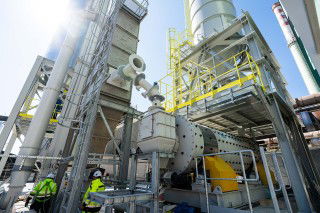Most, if not all, of the multinational cement producers have, stated their sustainability and environmental targets for decarbonisation. Cementos Molins SA, a leading Spanish cement manufacturer with overseas operations in Mexico, Chile, Colombia, Bolivia, Croatia, Germany, Argentina, Bangladesh, Uruguay and Tunisia, has released a revised 2030 sustainability roadmap.
The new targets replace initial emission reduction plans made in 1990 and place special emphasis on producing carbon-neutral concrete by 2050. By 2030 Cementos Molins will cut CO2 emissions by 20 per cent from its 2020 levels of 593kg CO2/t of cementitious material produced. However, it has an overall goal to reach below 500kg CO2/t of cementitous material produced by 2030. It also plans to achieve an energy substitution rate of 40 per cent by 2030 and significantly reduce the amount of clinker in its cement to 68 per cent across its entire production base.
A key goal in the new plan is to replace 40 per cent of fossil fuels with alternative fuels. The company already uses biomass in its kilns: in Argentina it uses sunflower hulls and peanut shells, while in Uruguay rice husks are used. In Tunisia, olive stones are used as kiln fuel. In 2020 the company managed to set a record substitution of 44 per cent alternative fuel usage. Pronatur, part of Promsa, produces alternative fuels from non-hazardous industrial waste for co-processing at Cementos Molins facilities.
Renewable energy will also be sourced for 55 per cent of all electrical consumption by 2030. As part of this investment, a 20MW photovotaic solar farm is providing 50 per cent of the energy requirements for the Cementos Avellaneda San Luis plant in Argentina.
NOx emissions of the group are to be cut by 40 per cent to 1400g NOx/t clinker and SOx emissions will be reduced by 10 per cent to 32g SOx/t clinker by 2030. Cementos Molins’ total emissions of NOx were 28,490t in 2020 and SOx emissions reached 460.236t, some 23.6 per cent higher than in 2019, while emissions of particulate matter were 1109t, 34.7 per cent more than in 2019. The company has targeted a reduction in particulate matter of 50 per cent to 50g/t clinker by 2030.
Target reduction comparison with industry peers
Direct like-for-like comparisons between other leading cement producers are not always simple as measurements are from larger and smaller-sized companies, while different base levels are taken for reduction targets. However, comparing Cementos Molins' 2030 targets to industry leader Holcim and the Global Cement and Concrete Association (GCCA) reveal that it is on a positive emissions drive but could go further in some areas.
By 2030 Holcim, for example, aims to cut its CO2 emissions to 475kg/t of cementitious material, from 561kg/t of cementitious material in 2019. Holcim also aims to have its first net-zero cement plant in operation by 2030. Furthermore, Holcim is focussed in Europe on seeing its 54 cement and grinding plants reduce CO2 emissions by 15 per cent by the end of 2022 from their levels in 2019.
Holcim increased its use of alternative fuels in Europe by 10 per cent in the first six months of 2019. The Cizkovice plant in Czech Republic already operates 100 per cent on alternative fuels. The Swiss giant found it more challenging to reduce NOx emissions in 2020, cutting them by just 0.3 per cent. However, Holcim stated in 2015 that it would reduce clinker content in its cement to 65 per cent by 2030, three per cent lower than Cementos Molins.
The GCCA’s 2030 Roadmap seeks members to align their targets to cut CO2 emissions by 20 per cent from the 2020 baselines, which Cementos Molins is mirroring.
Summary
Cement companies of all sizes have spent the last 12 months announcing medium- and long-term carbon reduction targets, as momentum builds in the industry to address the large-scale carbon emissions from cement production. While many of these targets are largely aligned with each other, the pressure is now on to deliver across a range of commitments which will gradually transform the industry over the coming decade. An interesting question in whether small companies such as Cementos Molins will be more agile than giants such as Holcim in adapting to the low-carbon future. Time will tell.
